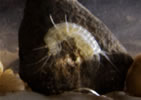Definitions
Aerobic (bacteria) - requires the presence of oxygen
Anaerobic (bacteria) - can live in the absence of, and does not require, oxygen
Amphipod - a type of crustacean with the body flattened laterally e.g. freshwater shrimp. Successive pairs of limbs tend to be modified differently.
Arthropod - invertebrate in the phylum Arthropoda having jointed limbs, segmented body and exoskeleton made of chitin e.g. crustaceans, insects, spiders, mites, ticks, millipedes.
Base rich - rocks/soils with relatively little silica (as opposed to acidic that have relatively high levels).
B.P. - years before present; as a convention, 1950 is the year from which B.P. dates are calculated. It is commonly used when radio carbon dating.
Freeeliving - animals and plants that live independently i.e. not parasitic.
Cavernicole - a more general term for a creature that lives in a caves and can complete its life cycle there, but may also live in other dark habitats e.g. soil, under stones, bark. It includes troglophiles and troglobites, not visitors.
Chemotroph - Chemotrophs are organisms that obtain energy by the oxidation of electron donating molecules in their environments. The chemotroph designation is in contrast to phototrophs which utilize solar energy. Chemotrophs can be either autotrophic (utilise simple inorganic sources such as carbon dioxide, water, nitrates), or heterotrophic (energy obtained from oxidation of organic compounds).
Isopod - a type of Crustacean with flattened bodies (as if they have been stood on like a woodlouse). The seven pairs of visible legs are essentially similar.
Lux - the SI (International) unit of illuminance, frequently defined as one lumen per square meter (lm/m2). (One lux equals 0.0929 footcandles).
Silicified – process during fossil formation in which organic matter is replaced by silica.
Troglophile - can successfully complete its life cycle both in and out of the cave environment.
Troglobite - cannot complete life cycle outside of the cave environment. These have morphological adaptations to the cave environment e.g. blind, longer legs, lower metabolic rate.
|
Cascade Cavern, Afton Red Rift |
|

